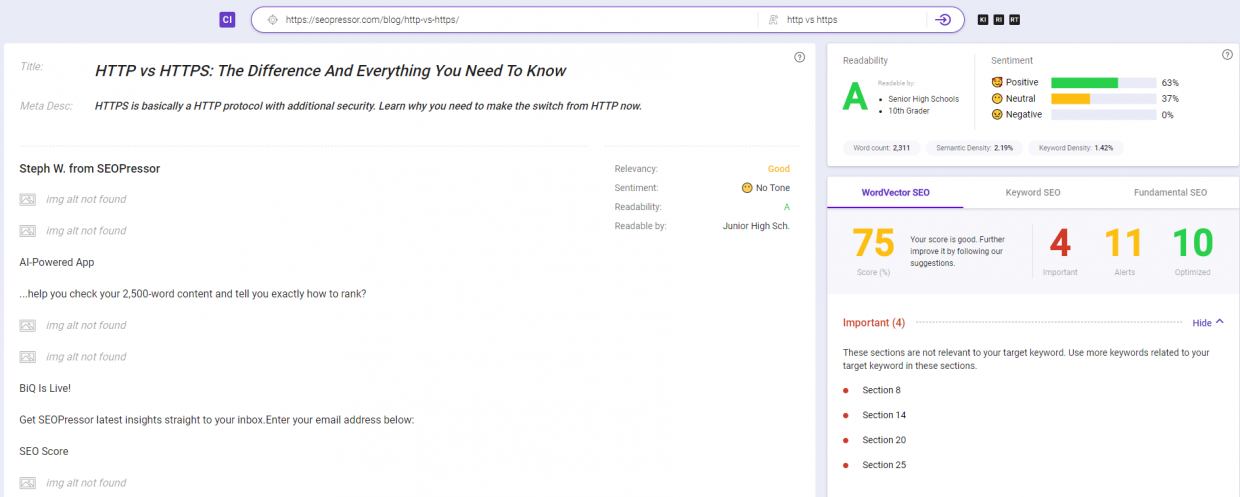Getting traffic is never easy. If you have done everything by the book and the traffic still doesn't find its way to your blog, fret not. Here we will show you how to get the buzz for your blog!
Gone are the days where updating your blog or even putting out new content can attract a huge amount of traffic.
Though there are still some SEO gurus out there who preach that churning out good quality content daily would get you traffic, they are not 100% wrong – but they are not 100% right either.
Nowadays, good quality content and updating your blog frequently is just the bare minimum.
There are more factors that you need to consider, in order to multiply the traffic to your blog. These are 13 genius ways you can do that.
1. Write more frequently and consistently
Now we know what we said, and again, this is just the bare minimum. However, it is not easy to create new content every day for your blog. It is again, a game of the fittest and hardworking that will “survive” or in other words, get traffic.
Google prioritizes fresh websites with fresh content, so if you want to get more attention from the search engines, you need to be updating your blog at least twice a week.
2. Promote your content with social media
Creating good quality content is not enough for people to find it. What you can do is to get proactive in social media to promote your content. After all, social media is a place to share everything and anything!
Twitter is ideal for short and tempting links. If you’re up for paid promotion, try LinkedIn promotion as it can help your site show up in personalized search results, especially in B2B niches.
Always engage with your followers because nothing turns people off quicker than using social media as a broadcast channel.
If you know how to take advantage of social media, it will be one of your top sources of traffic.
3. Create titles with higher click-throughs
Always analyze your headlines before hitting the ‘publish button. Ask yourself this question before publishing:
Is your headline irresistible enough? If the answer is no, then you should definitely consider restructuring your title.
The point of this is to make sure that your title is catchy enough that it will result in more click-through rates. Put on your creative hat and start creating engaging and powerful titles.
Take the writers at Buzzfeed and Upworthy as an example. They come up with 20 different headlines before finally settling on one that will drive the most traffic. So, when you do the same, it will definitely increase your readership.
4. Create your own visuals and infographic
Visuals are as important as the headlines. Why? This is because the human brain craves visuals. This is more important if you want to share your content on social media.
The right or creative image will make the blog irresistible as readers would want to know how the image relates to your blog.
Avoid taking images or infographics from the Internet to avoid copyright laws. Instead, create your own image to stay on the safe side. On the bright side, you can now create your own visuals and infographics which will be more appealing than others.
Make sure that your images are optimized so that your ranking in the search engine gets boosted. One way you can SEO optimize your images is to include keywords in your Alt Image tag.
5. Optimize your content with your target keywords
If you really want to drive big-time traffic to your site, do not be afraid of keywords! Speaking of SEO, keywords are like protein bars for them.
Don’t be shy, add more keywords. Simplify this step with BiQ’s Keyword Intelligence tool. Aim for more long-tail keywords as they have lesser competition.
First, you can enter your target keyword in the Keyword Intelligence. You will first see a list of related keywords with a mixture of short and long-tail keywords.
Click the ‘Advanced Filter’ to filter only long-tail keywords. You may also choose the level of your long-tail keywords relatedness to your main keywords.
If you are unsure which keyword to use, you can sort the keywords based on their value. The higher-valued keyword means it can potentially bring more traffic to your website at a lower competition.
Once you have your keywords, you can start drafting your content in BiQ’s Content Intelligence. The content analysis tool will provide you real-time analysis as you type in your content.
On the other hand, BiQ’s Content Intelligence also doubles as a content optimizing tool for your existing content. All you need to do is simply insert your content URL and target keyword.
It will compare your content to the WordVector of the Top 10 ranking results and provide suggestions for optimization.

But here’s another reason why BiQ Content Intelligence is a fantastic option for content teams; their keyword research ability that is found in the tool.
If you’re looking to get a general lay of the land before creating a content outline, this will be the perfect fit. Type in the main keyword and BiQ will give you a list of 20-30 related terms to include in your content.
6. Create cornerstone content
What is cornerstone content? Well, it is the few best or top contents that the site built around. It is the important article on your site, that you want them to rank the highest.
Keywords are very important for SEO. When you have a good value keyword, your blog will definitely rank high, hence more traffic!
Get evergreen keywords with BiQ’s Keyword Intelligence tool. You can look for newer and trending keywords using the Trending Searches feature in BiQ’s Keyword Intelligence.
Trending searches show the latest keywords or topics around your selected keyword. It helps you discover what trending searches people are searching for online.
This content is relatively long and informative, combining different insights from other sources and basically covering every question that will be asked about a certain topic.
Cornerstone content is easier to rank in SEO, as they are less competitive. It is harder to rank for more popular keywords or topics.
7. Build a content silo
A content silo is a method that groups related content together. This is to establish your website’s keyword-based topical areas or themes.
Not only does content silo help your readers to navigate through your website easily, but it also helps the search engine. Because like any real visitor, they need to have a good understanding of what your page is about, how it’s structured, and where it is located.
Search engines award keyword relevancy based on the page’s content as well as the relevancy of the entire website.
Hence, if you want to rank for a particular keyword, make sure that you have a separate section in your website related to the keyword and not just one page.
8. Interlink your blog posts
Interlinking is when you link one of your own pages to another internally within a website.
Since you can control your site you can control your blog’s entire internal linking structure. This is important for traffic because of how the search engine functions.
They use little software programs called “spiders” that will crawl around the web, following links and indexing all the content web pages.
Just remember that the strength of your link profile is not only based on how many sites link back to you but also on your internal linking structure.
9. Send an email newsletter
Email marketing is one of the under-rated marketing strategies which also has a high ROI.
What you can do is send a snippet of your blog in your email newsletter, and make sure to include a link to it. Not everyone will have the time to read your blog each week, so sending an email newsletter might remind them and you can even get your subscribers invested in your blog.
10. Invite guest contributors

Guest blogging is a two-way street. In addition to posting content to other blogs, invite people in your niche to blog on your own site.
It is more content to your blog site that you didn’t have to write your own and they are more likely to share with their networks and may ask you to write for them, opening up new readership avenues for you.
These are the steps on how to successfully invite guest bloggers to help grow your blog.
Step 1: Establish clear submission guidelines. This is to avoid any low-quality work.
Step 2: Invite contributors by sharing your guidelines. Share the guidelines with the people you’d like to see contribute to significantly improve your guest list.
Step 3: Use templates for accepting and even rejecting post ideas.
They might also link that blog to their own site and this could potentially bring in more new readers too!
11. Repurpose your content into video
Repurposing your old content is a great way of educating your existing customers and winning new ones without creating new content.
You could reformat your content into videos like Instagram videos or TikTok videos. These two social media platforms have huge amounts of users who are watching videos every day.
You could also format them into Youtube videos and if they do well, it could be another source of income for you. 54% of people use Youtube to learn and satisfy their curiosity.
Globally, 90% of people have said to discover new brands or products through Youtube.
12. Optimize your user experience
Nearly 95% of consumers distrust websites with poor design.
If you think that user experience is only for the readers, then you are wrong. It is equally important for search engines.
When the target audience gets to your website and lands on its pages, it is the UX that gives them the answers to their questions and the solutions to their needs.
The goal of optimizing your web page is to improve the user experience upon landing on the website. Without it, all SEO efforts collapse. What good is your customer presence if they don’t stick around to actually make your site successful
These are 3 tips on how to optimize the user experience:
- Reduce loading page time. According to the 2018 research by Google, it takes three seconds for a person to leave your age because it takes time to load.
- Do language research. Check on the style and wording that are commonly used in the industry to describe a market similar to your product or services.
- Intent research. Not all keywords that show up in the search results carry the same meaning for the target audience. Hence you need to do research on the intent. Again, you can easily do this with BiQ’s Keyword Intelligence tool.
Let’s say you want to know the searcher’s intent when searching for ‘content marketing.’ Type them into the keyword tool.
The keyword has an informational intent from the example above, which means the searchers are in the awareness stages.
Since the searchers are looking for more information, you can create informational content such as ‘why do you need content marketing?’ and ‘top content marketing examples’.
Scroll down and you’ll be able to identify each keyword intent so that you can understand your target audience better.
That is a great help because it eliminates assumptions and guesswork to identify the searchers’ intent.
13. Foster a sense of community
When people are really members of a community, they feel a strong psychological connection to that group.
They would want to speak their minds and provide their thoughts and opinions on subjects that they feel passionate about, so building a community into your website is a good way to start conversations.
When there is a sense of community among your readers, they might share your blog topics with their friends who share the same interest and hence you have more readers and more traffic!
Sense of community has been shown to significantly increase activity, increase customer loyalty and buying behavior, higher levels of brand advocacy, increase knowledge exchange, and reduced the tendency to engage in negative behaviors.
Conclusion
We challenge you to try these techniques. If it works and at least brings in some amount of traffic let us know in the comments!
If you have tried all of our techniques recommended and have not seen any results thus far, comment down below too so that we can work on the problem together!
Gaining traffic does sound like a lot of work, but well, know that it’s worth the effort! So start using these 13 ways to get traffic to your blog today.




